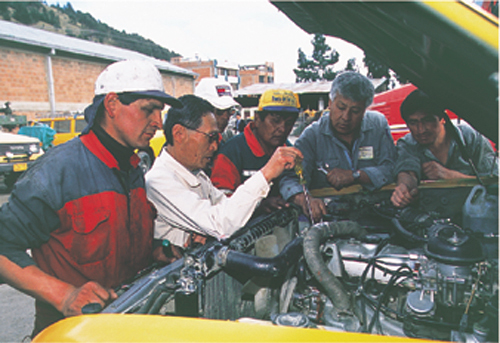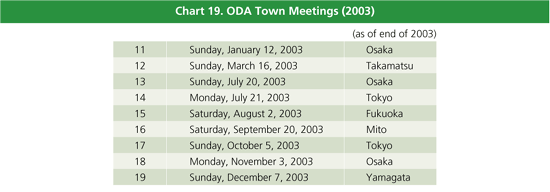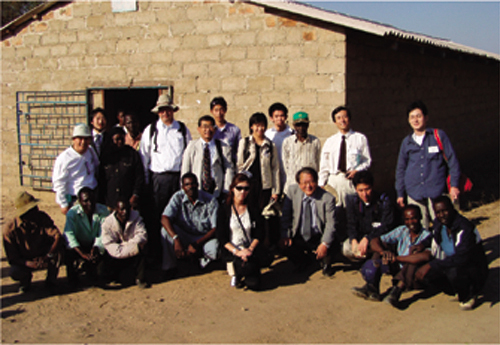

| Part I. | THE REVISION OF THE “ODA CHARTER” AND JAPAN’S NEW APPROACH |
In recent years, the people of Japan have increased their social
contribution through volunteer activities, etc. and the people who are highly
motivated to participate in international cooperation activities are rapidly
increasing. The revised ODA Charter states that the government will respond
to the demands of the people of Japan regarding international cooperation by
“providing sufficient information to foster participation in assistance
activities by Japanese citizens from all walks of life, and to promote these
citizens’ interaction with developing countries. Such measures will include
providing sufficient information.” The charter also states that the government
will take measures such as “listening to public opinion, soliciting proposals
for ODA activities, and extending cooperation to volunteer activities,”
to facilitate active participation by the public in assistance activities
These measures to increase public participation are reflected in the review
of the Country Assistance Plan for Viet Nam, which the government has been formulating
since fiscal year 2002 and in the formulation of the Country Assistance Plan
for Sri Lanka. These processes were commenced taking into account discussion
in the Board on Comprehensive ODA Strategy and are thought to contribute to
realizing more specific public participation and to increasing the transparency
of ODA. The “open network method” was adopted in the review process
for the Country Assistance Plan for Viet Nam and it was determined that “the
state of progress would be publicly disclosed except for matters which are faced
by particularly serious diplomatic consideration,” a site for the Country
Assistance Plan for Viet Nam was set up within the MOFA ODA website and a wide
range of views were collected. When it came to formulating the country assistance
plan, the “4Js”—the “country-based ODA task force”
led by the Japanese embassy in Viet Nam and additionally comprised of JICA and
JBIC, and JETRO—took the lead in drawing up the draft and they widely consulted
with people involved in local companies and NGOs in this process. In Tokyo,
exchanges of views were held with ODA-related government ministries and agencies
and related Japanese NGOs on a total of four occasions. Exchanges of views were
also held with experts and comments were widely sought before the final draft
was drawn up. As a result of the fact that wide-ranging views from the ODA-related
government ministries and agencies, NGOs, and the public were reflected in this
process, the extremely transparent “open network method” was highly
praised. And in the formulation of the Country Assistance Plan for Sri Lanka,
exchanges of views were held with ODA-related government ministries and agencies
on two occasions and NGOs, private companies, experts, other donor countries
and international organizations, both in Japan and in the recipient country,
were widely consulted. And MOFA worked to realize public participation in the
formulation of the second draft of the country assistance program. For example,
the draft was made available to the public through the MOFA ODA website for
a period of approximately one month and views and comments were widely sought
from the public.
Concerning participation in ODA by Japanese citizens from all walks of life,
there is the program for the dispatch of senior volunteers. This is a public
participatory project under which JICA supports the activities of senior citizens
aged between 40 and 69 who possess a wide range of skills and abundant experience
and who are interested in contributing to the development of developing countries
on a volunteer basis. It was launched as “Senior Cooperation Experts”
in fiscal year 1990 and it was positioned as the volunteer project which is
the senior version of the Japan Overseas Cooperation Volunteers (JOCV) and renamed
the “Senior Volunteer” in fiscal year 1996. As of the end of November
2003, 799 senior volunteers had been dispatched to 51 countries and a total
of 1,699 senior volunteers had been dispatched overseas.
Recruitment and selection are carried out twice a year, in spring and autumn.
In the first examination, the documents and skills of the candidate are examined
and they are given a preliminary medical examination; in the second examination,
there is an interview, language examination and follow-up medical examination.
Training before the volunteers are dispatched includes orientation (two weeks)
and language training (three weeks). The period of duty is in principle one
or two years, the volunteers belong to a government organization in the recipient
country and transfer skills to human resources in the developing country through
teaching, advice, surveys, etc.
 |
| A Senior Volunteer teaching how to repair a car engine (Photo: JICA) |
| Column 10 | Medical Cooperation in Afghanistan—Emergency Winter Medical Aid in Kabul | |||||
|
The Emergency Loya Jirga (Grand Assembly) was held and the Transitional Administration of Afghanistan inaugurated in June 2002. As the domestic situation stabilized, the refugees who had fled to Pakistan, Iran and other countries returned to Afghanistan but the social infrastructure had been destroyed by the long civil war and there were no jobs or housing for the returnees. International support will continue to be necessary for some time to come because the level of distress of people in Afghanistan is showing no signs of improving.
|
||||||
It is people that implement assistance, so securing and utilizing
development personnel is extremely important to advance assistance efficiently.
Therefore, there is a great need to foster experts possessing advanced knowledge
and skills in each developmental sector and issue, and who are strongly international-minded.
Discovering and fostering development personnel is also important for promoting
public participation and enhancing efficiency, two of the key goals of ODA reform.
The revised ODA Charter states that Japan will “foster aid personnel with
the necessary expertise” and will “increase the opportunities”
for aid personnel to be active both within Japan and overseas and that “high-quality
personnel, such as persons with considerable overseas experience and extensive
knowledge, will be widely sought and be encouraged to participate in ODA activities.”
As one of these measures, in response to the ODA reform discussions, the “Participatory
Network for Expert Recruitment (PARTNER)” was established within JICA in
October 2003. In order to effectively utilize human resources widely involved
in international cooperation, PARTNER is providing information concerning international
cooperation-related job vacancies at JICA and other institutions, registering
people within the JICA International Cooperation Personnel Registration System,
providing information about training and seminars, etc.
| Column 11 | The Project in which the Children of Japan Provide Rice to Cambodia | |||||
|
Due to the effects of the long civil war in Cambodia beginning
in the 1970s, the food shortages still commonly occur. The long-running
civil war destroyed the socio-economic infrastructure and the large
number of land mines is a terrible legacy of the conflict that is hindering
the reconstruction of Cambodia, in particular the development of the
villages. According to a fiscal year 2002 World Food Programme (WFP)
survey, about 36% of the entire population is suffering from malnutrition.
|
||||||
| |
Collaboration between Universities and Research Institutes |
From the perspective of making assistance more effective, regional studies relating to developing countries and research on development policy are indispensable. The revised ODA Charter states that these kinds of research are to be encouraged and that the government will promote accumulation of Japan’s intellectual assets in the development sphere.
In order to understand accurately the needs of developing countries and follow appropriately the trends in the international community, JICA is welcoming external experts affiliated with universities and research institutes, into its committees, and is carrying out research activities on issues and themes related to development and assistance. Specifically, it is implementing (1) research on assistance strategies aimed at priority countries/regions and sectors/issues (2) research on aid methods relating to aid skills and methods; and (3) research on important specific issues in provision of aid. JBIC also invites guest researchers to participate in its research and in cooperation with international organizations such as the World Bank, etc., is implementing survey research concerning development assistance issues, development policy, etc., for example, it carries out joint research with Japanese and foreign researchers.
In addition, the “Support and Coordination Project for University Cooperation
in International Development” was started in July 2003 to widely utilize
the intellectual resources possessed by Japan’s universities in development
cooperation and to enhance collaboration with assistance organizations. The
development of an environment to enable universities to participate in development
assistance through the development of a database, the holding of training, etc.
is also proceeding.
Development education raises the children’s interest in development
issues, promotes their understanding of ODA and other forms of international
cooperation, and fosters their appetite for international cooperation. With
this in mind, the revised ODA Charter states that the government will take measures
in schools and on other occasions to carry out more widespread education on
development issues, such as “the problems that face developing countries,
relations between Japan and developing countries and the role that development
assistance should play,” that for this purpose, “necessary educational
materials will be distributed and teachers will be trained,” and that development
education will be promoted.
MOFA, JICA and JBIC have been taking active measures to promote
such development education. MOFA has long distributed development education
teaching materials to elementary and junior high schools, and in early 2002,
when the “period for integrated study” began, it distributed development
education teaching packages (consisting of Photo Language Quiz Cards, instructional
materials, and videos) to 2,000 public libraries and 3,000 elementary and junior
high schools around the country. And currently, MOFA is in the process of making
a development education promotional website targeted at senior students of elementary
school and junior high school students. For ten years now, MOFA, JICA, and JBIC
have been making efforts to disseminate development education by holding seminars
on the subject in various parts of the country, dispatching speakers to elementary,
junior high, and high schools, welcoming children on school trips and other
occasions, supplying information relating to development education via their
websites, enabling teachers to visit ODA field sites, and organizing essay contests.
In addition to the above measures, MOFA has also begun new measures reflecting
the formulation of the revised ODA Charter. The “Fifteen Specific Measures
for ODA Reform” announced in July 2002 recommended that all domestic JICA
offices carry out development education programs in order to “explore,
foster, and utilize human resources” and the revised ODA Charter pointed
out the importance of development education; so MOFA has widely held development
education related seminars —human resources development seminars, development
education general seminars, etc. —in addition to the development education
regional seminars and national assistance providers conferences that were already
being held. JICA is holding seminars for development education teachers and
domestic programs for students, and is disseminating development education from
a variety of perspectives, primarily to elementary and junior high schools,
for example, by assigning former JOCVs to serve as Coordinators for International
Cooperation in international exchange associations throughout Japan.
ODA plays a big role in Japan’s diplomacy. In order to utilize
it to advance development assistance for developing countries, it is essential
to promote widespread public understanding of and support for ODA. The revised
ODA Charter states that “it is important for information on ODA policy,
implementation, and evaluation to be disclosed widely and promptly to ensure
the sufficient transparency, and for it to be publicized actively.” The
charter goes on to say that for this reason, “the government will use a
variety of means to provide information in easy-to-understand formats”
and “create opportunities for Japanese citizens to come into contact with
ODA activities that Japan is undertaking” so that they can understand the
significance and role of ODA.

| |
Vigorous Public Relations and Provision of Information within Japan |
Specific policies to provide information and create opportunities
for Japanese citizens to come into contact with ODA activities include the following.
| (1) | ODA Mail Magazine In addition to the ODA website, MOFA began issuing the ODA Mail Magazine in July 2002. As of the end of December 2003, the e-mail bulletin had been issued 33 times. The magazine relays timely topics and information relating to economic cooperation and includes episodes written by Japanese embassy staff members, JOCVs, and Senior Volunteers about their actual experiences in the field and introduces ODA-related anecdotes. Anyone can receive the magazine by registering on the ODA website as needed. As of the end of December 2003, more than 7,200 people had registered. |
| (2) | ODA Town Meetings As part of an effort to promote dialogue with the public, ODA town meetings are held regularly at various places around the country to inform the public of how ODA reform is being carried out and to listen directly what the general public think about ODA and these reform efforts. Town meetings were held on five occasions in fiscal year 2001 and on seven occasions in fiscal year 2002, and by December of fiscal year 2003, seven meetings had been held, in Osaka, Tokyo, Fukuoka (these three meetings were held as public hearings concerning the ODA Charter), Mito, Tokyo, Osaka and Yamagata. They were the scene of frank discussions between experts, members of the Board on Comprehensive ODA Strategy, senior officials of MOFA’s Economic Cooperation Bureau, and the general public. |
| (3) | Dispatch of Monitors The aims of the Monitoring Group of Citizens on Japan’s ODA are to promote a proper understanding of the significance and importance of ODA by selecting monitors from among members of the general public who have an interest in ODA and dispatching them to ODA project sites, thereby giving them a firsthand opportunity to inspect Japan’s ODA projects, and to receive proposals concerning ODA consisting of views and feedback from the monitors. This program was started in fiscal year 1999, and by fiscal year 2003, a total of 406 monitors had viewed ODA projects in developing countries in Asia, Africa, and Latin America. Participants have reported35, for example, that they have deepened their understanding of the role that ODA plays in the development and stability of developing countries and of the need for assistance. Japan intends to continue to work to deepen the public’s understanding of ODA through this program. |
 |
| ODA Monitors (Zambia) |
| |
Strengthening of the Dissemination of Information to the International Community |
In addition to the public relations within Japan described above,
it is also important that Japan’s active international contribution through
ODA is properly understood and supported overseas. One of the growing interests
surrounding ODA reform is an increased interest in publicizing Japan’s
ODA in the recipient country and public relations efforts that explain the achievements,
etc. of Japan’s ODA to the people of the recipient country in an easy-to-understand
way are required. In order to ensure that Japan’s assistance is evaluated
correctly overseas and to publicize the fact that each individual project was
created through Japan’s assistance, Japan has cooperated on interviews
with the local press at signing and handover ceremonies, attached a Japanese
flag sticker (English, Arabic) and the Japanese ODA logo (English, French, Spanish,
Arabic) to goods supplied through assistance, set up signs, etc.
The revised ODA Charter states that “the government will make enhanced
efforts to disseminate information regarding Japan’s ODA to (the international
community such as) developing countries as well as other donors” in addition
to the above measures and advocates the enhancing of the dissemination of information
overseas. Specifically, in order to present Japan’s ODA policies and results
widely to the people of the recipient country, Japan has promoted television
programs introducing Japan’s ODA and broadcasted them through satellite
networks36 and has arranged visits to Japan’s
ODA project sites for the local press. Also, Japanese embassies overseas, in
cooperation with JICA, JBIC, etc., have published pamphlets concerning Japan’s
ODA. In 2003, they wrote and distributed these pamphlets in Bangladesh, Viet
Nam and other countries. To the international community, including other donor
countries, Japan is taking active measures to disseminate information through
daily diplomatic efforts in the series of international conferences explained
in Part II, and by holding a variety of symposiums and seminars. In 2003, the
Initiative for Development in East Asia (IDEA) Fukuoka Symposium and a variety
of seminars concerning the Asian economy, the ODA Charter and Africa in the
Organisation for Economic Co-operation and Development – Development Assistance
Committee (OECD-DAC) were held.
35. The ODA Citizen Monitoring Program Report is available on the ODA site (in Japanese).
36. A program to publicize ODA called “Asian Dream” was broadcast to the entire Asian region (from Northeast Asia to South Asia. It could also be seen in the Middle East and Israel, and was available to a total of about 16.93 million households) through the satellite broadcasting “Star World” in March 2003. It presented Japan’s wide-ranging cooperation to Asia. It was also rebroadcast in Viet Nam in June 2003 through a local television station, dubbed into Vietnamese.